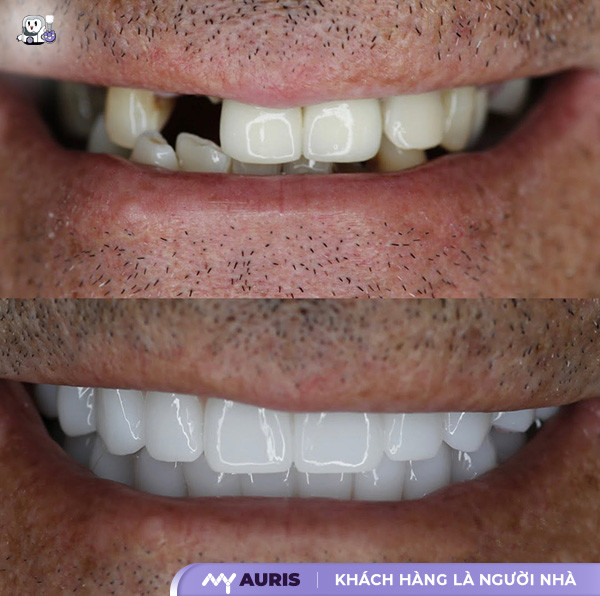Dental implants are currently an advanced method to restore missing teeth, providing stable occlusion and significantly improving chewing ability. However, in some rare cases, implants can be rejected due to various factors such as individual constitution, underlying medical conditions, or improper care procedures. Early recognition of abnormal signs will help you proactively address and protect treatment outcomes. Discover the detailed information below to find the most effective and safest solutions!
What are Dental Implants?
Dental implant placement is an advanced tooth restoration method in the field of dental implants, widely applied to replace missing teeth. The dental implant post is typically a small screw-shaped structure made of Titanium, a material with high biocompatibility with the human body, especially with the jawbone. After being surgically placed directly into the bone, this post will firmly integrate with the jawbone, thereby creating a stable foundation for the prosthetic dental crown placed on top.
Not only do implant teeth resemble natural teeth, but they also perform chewing functions well, ensure aesthetics, and effectively prevent bone loss. Dental implant placement is an ideal solution for many cases, such as: losing a single tooth, losing multiple consecutive teeth, or complete arch tooth loss due to accidents, diseases, or congenital conditions.

What is Implant Rejection?
Implant rejection is a phenomenon where the dental implant post fails to integrate with the jawbone, leading to a loss of firm connection between the jawbone and the post. When osseointegration fails, the implant post is no longer stable, directly affecting chewing ability, aesthetics, and potentially leading to implant failure if not detected early.
Implant post instability can occur at various stages of the treatment process:
- During the initial phase, as the wound heals after implant placement
- While placing the prosthetic crown on the implant post
- Or after the entire implant placement procedure is completed
If not addressed promptly, implant post rejection can lead to jawbone loss, infection, and prolonged pain, making re-treatment difficult. Therefore, close monitoring, early diagnosis, and proper surgical technique are key factors in increasing success rates and minimizing the risk of implant failure.

Recognizing Early Signs of Implant Rejection to Protect Oral Health
After dental implant placement, the body typically needs about 3 months for the post to firmly integrate with the jawbone. However, if any of the following abnormal symptoms appear during this period, it is highly likely that you are experiencing implant rejection – a serious complication that requires prompt attention.
Abnormal Looseness of the Implant Post
If you feel the implant wobbling, it could be due to excessively weak jawbone density or improper surgical technique during placement, preventing full integration of the post. This is a common sign indicating that the implant is at risk of being rejected by the body.
Implant Protrusion and Exposure from the Gums
Implant protrusion often occurs when the dentist places the post in the wrong position or fails to adequately control post-surgical infection. This prevents the implant from firmly attaching to the bone and makes it prone to being pushed out of its original position.
Implant Site Infection
Mild swelling and pain after implant placement are normal. However, if implant infection persists, accompanied by pus or an unpleasant odor, you should seek medical attention immediately. Untreated infection can lead to permanent implant rejection.
Rejection After Crown Placement
Some cases of implant rejection after ceramic crown placement may be due to excessive chewing force, weak jawbone, or sub-standard implant posts. This prevents the post from fully integrating and quickly leads to its rejection by the body.
Important Considerations When an Implant Post is Rejected
Solutions to Address Implant Post Rejection
Upon detecting implant post rejection, you need to take appropriate action to avoid serious oral complications. Here are effective solutions, recommended by specialized dental implant practitioners:
Signs of implant post rejection typically include: gum bleeding, sharp tooth pain, numbness, and redness or discomfort around the implant site. When this occurs, the first thing you should do is stop the bleeding by using clean dental gauze, placing it over the bleeding area, and biting down firmly for about 15 – 20 minutes.
If the area around the implant continues to be painful or numb, you can use a cold compress to reduce swelling. Place a few ice cubes in a clean cloth, then gently apply it to the area showing signs of implant post rejection. However, this method is only temporary and does not replace the need for a dental examination.
Most importantly, never self-medicate without a doctor’s prescription. Incorrect use can lead to dangerous consequences, making it impossible to preserve the implant post and requiring its removal.
As soon as abnormal symptoms appear, you should remain calm and visit a reputable dental clinic for examination and timely intervention. The dentist will accurately assess the extent of implant post rejection and propose an appropriate treatment plan to comprehensively protect your oral health.

How to Effectively Prevent Implant Post Rejection?
To ensure optimal effectiveness of the implant placement process and minimize the risk of implant rejection, in addition to recognizing warning signs and acting promptly, you need to proactively prevent it from early stages by following these methods:
Deciding to restore teeth with an implant post requires you to choose a reputable dental practice with an experienced team of dentists and modern technology. This is a crucial factor to ensure a safe, effective, and long-lasting treatment outcome.
Consult with a specialist to select an implant post type that has high biocompatibility with the jawbone, suitable for your individual constitution and oral condition. This helps reduce the risk of implant rejection while increasing the stability and lifespan of the implant post in the oral cavity.
Maintain regular follow-up appointments every 1-2 months for the dentist to check the degree of integration between the implant post and the jawbone. This is an opportunity to promptly detect and address any abnormal signs during the tooth restoration process.
After dental implant placement, use a soft toothbrush, dental floss, and mild mouthwash to clean your mouth daily. This helps remove bacteria, reduce inflammation around the implant post, and support the osseointegration process more effectively.
During the first few weeks after implant placement, avoid eating foods that are too hard or chewy, or using your teeth to tear food. Instead, prioritize soft, easy-to-chew foods to ensure the stability of the implant post and promote healing.

Preventing Rejection After Dental Implant Placement
Preventing implant rejection is a crucial factor in maintaining implant longevity and ensuring long-term oral health. Here are practical measures recommended by specialists to minimize risks and increase implant stability after placement:
Before undergoing dental implant placement, patients need to be thoroughly examined and have existing conditions such as periodontitis, tooth decay, alveolar bone loss, etc., completely treated. If these issues are not treated beforehand, they will weaken the jawbone’s strength, severely impacting future implant stability.
An experienced dentist will assess jawbone density and volume to propose suitable options such as immediate implant placement, bone grafting, or sinus lift. Concurrently, using implant materials with high biocompatibility helps increase integration capability and reduce rejection.
After implant placement, proper implant care plays a decisive role in the long-term outcome. Patients need to meticulously clean their mouths daily using a soft toothbrush and dental floss, while also adhering to the follow-up schedule as instructed by the dentist to detect abnormal signs early and prevent peri-implant infection.
If the implant is incompatible and rejected, patients will face the risk of jawbone loss, permanent tooth loss, and severe impacts on chewing ability and aesthetics. Therefore, proper implant care from the beginning is the way to maintain long-term effectiveness and comprehensively protect oral health.





